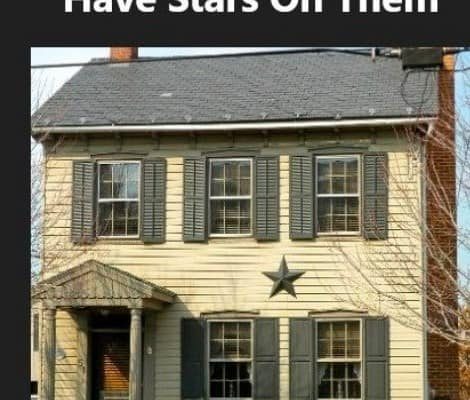But have you ever wondered what these stars truly symbolize?
These iconic barn stars hold a rich history and hidden meanings that go beyond their charming appearance.
What is a Barn Star?
A barn star (also known as a barnstar, primitive star, or Pennsylvania star) is a decorative symbol commonly found on barns in in south-central and southeastern Pennsylvania.
Barn stars are usually geometric designs, often featuring five, six, eight, or twelve points, and sometimes appear in a circular “wagon wheel” style.
When did Barn Stars first appear?
To trace the origins of the barn star in North America, we need to go back about 300 years. Religious refugees from the Rhine region of Germany, including Amish, Mennonites, Lutherans, and other groups, made their way to southeastern Pennsylvania in search of religious freedom.
These settlers became known as the “Pennsylvania Dutch.”

These settlers brought a tradition of painting vibrant geometric patterns on their barns. These designs, often featuring flowers, birds, stars, and other symbols, had specific meanings, alongside their decorative charm.
Barn stars first made their appearance in the 1830s, but by the time of the Civil War, their popularity really took off, especially in Pennsylvania, where they remained a beloved tradition as late as the 1870s.
What is a Barn star made of?
The composition of the barn star has evolved over time. Initially, they were painted directly onto the barn’s surface. Later, the stars were crafted from wood as separate pieces and then attached to the barn.
Metal barn stars are typically crafted from durable materials such as tin, steel, or iron, which give them a rustic charm and the ability to withstand the elements for years. On the other hand, wooden barn stars are usually hand-cut and painted, offering a more traditional and handcrafted appeal.
The purpose of Barnstar
I always thought barn stars served a structural purpose, but it turns out that’s not the case most of the time. While they don’t serve a building function, barn stars were once viewed as a symbol of good luck by farmers ”way back when,” and many people still consider them lucky today.
Similar to how a horseshoe is often hung over a doorway, barn stars are thought to bring good fortune. Over time, a story developed that Pennsylvania Dutch farmers painted these stars on their barns to ward off evil spirits or bring good luck. It seems, however, that the urban legend isn’t entirely true.
Experts have pointed out that barn stars were closely tied to the agricultural lifestyle. They were not necessarily linked to supernatural events or beliefs.
In the beginning, the barn star also served as the carpenter’s unique signature, marking the building he had crafted.

Significance of the colors
The original barn stars were smaller than the ones we see today and often featured the year the barn was constructed. According to Artistic-Garden, the colors of barn stars and hex signs can hold different meanings.
Black:
Protection, also used to blend or bind elements together.
Blue:
Protection, peace, calmness and spirituality.
Brown:
Mother earth, also can mean friendship and strength.
Green:
Growth, fertility, success in things and ideas that grow.
Orange:
Abundance in career, projects and matters needing an added push.
Red:
Emotions, passion, charisma, lust and also creativity.
Violet:
Things that are sacred.
White:
Purity, power of the moon, allows energy to flow freely.
Yellow:
Health in body and mind, love of man and the sun, connection to the God.
Barn Stars are not Hex signs
On older buildings in the Pennsylvania Dutch region, you can still find barn star-like adornments painted directly onto the surface, known as hex signs. These symbols, which are often confused with barn stars, carry their own unique significance.
At Kutztown University, Patrick Donmoyer, who oversees the Pennsylvania German Cultural Heritage Centre, emphasizes the importance of understanding the distinction between the two. As he explains, ”There are the barn stars, and then there are the hex signs.”
One reason for the confusion is spelled Wallace Nutting. In 1924, the New England artist visited Pennsylvania Dutch Country and mistakenly mixed up the original barn stars with quilt patterns, which led to the creation of hex signs.
Donmoyer explains, ”He was describing something real, but he misunderstood it. He wasn’t talking about the stars on the barns; he was actually referring to the hexenfoos. He combined two different traditions by accident.”
Whats the difference between hex signs and barn stars?
The main difference between hex signs and barn stars lies in their origins and symbolic meanings.
Hex Signs are a form of folk art that originated in Pennsylvania Dutch Country. They are decorative symbols, often featuring circular designs, geometric patterns, and vibrant colors. While barn stars are sometimes mistaken for hex signs, the latter have deeper roots in folk traditions, where they were believed to offer protection against evil spirits or bring good luck. Hex signs are often associated with mystical or spiritual meanings.
Barn Stars, on the other hand, are usually simpler, five-pointed stars or other geometric shapes. They are primarily used for decoration and are more closely tied to the agricultural lifestyle. While they can also be used for good luck, barn stars don’t carry the same symbolic weight of protection that hex signs often do.
Star-shaped anchor plates
The term “barn star” has also been used to describe star-shaped anchor plates found on old buildings, especially from the 18th and 19th centuries.
These cast-iron stars weren’t just decorative — they served a practical purpose.
They were used as washers for tie rods, helping to reinforce masonry walls and prevent them from tilting or bowing. So, while they look pretty, these barn stars also played a key role in keeping historic buildings standing strong.







